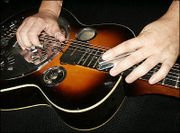
Resonator guitar played lap steel fashion.
Steel guitar is:
- A method of playing slide guitar using a steel. Resonator guitars, including round necked varieties, are particularly suitable
for this style, but other types are also used, usually with modified high actions, as well as instruments produced specifically for the
purpose.
- A specialised instrument built for playing in steel guitar fashion. These are of several types types:
- Lap steel guitar, which may be:
- Lap slide guitar, with a conventional wooden guitar box.
- The square-necked variety of resonator guitar.
- Electric lap steel guitar.
- Electric table steel guitar.
- Electric pedal steel guitar.
The name steel guitar comes not from the material of which the guitar is made, but from the name of the steel, a
slide held in the left hand.
Technique
Steel guitar refers to a method of playing on a guitar held horizontally, with the strings uppermost and the bass strings towards the
player, and using a type of slide called a steel above the fingerboard rather than fretting the strings with the fingers. This
may be done with any guitar, but is most common on instruments designed and produced for this style of playing.
The technique was invented and popularized in Hawaii, thus the lap steel guitar is sometimes known as the Hawaiian guitar,
particularly in documents from the early 1900s. However in Hawaiian music, Hawaiian guitar means slack string guitar, played in
the conventional or spanish position.
Steel guitar technique also developed from bottleneck guitar, which is a similar technique to steel guitar but with the guitar held in the
conventional position, and using a different form of slide to accommodate this playing position.
Instruments
A Steel Guitar is one designed to be played in steel guitar fashion.
Historically, these have been of many types, but two dominate:
- Resonator guitars, particularly the square-necked variety which can only be played in steel guitar fashion.
- Electric instruments, starting with electric lap steel guitars and developing through the table steel guitar to the pedal steel guitar.
Lap steel guitar
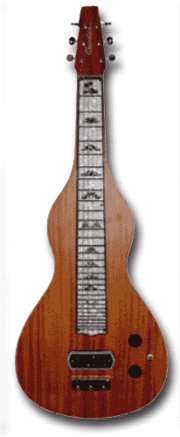
Chandler electric lap steel guitar, a solid body with the classic Weissenborn profile.
The lap steel typically has 6 strings and is tuned to either standard guitar tuning, or an open chord. It differs from a conventional or
Spanish guitar in having a higher action and often a neck that is square in cross section. The frets, unused in steel style playing, may be
replaced by markers.
There are three main types:
- Lap slide guitars, which are acoustic instruments but may have electric pickups for amplification in addition.
- Resonator guitars, which are also acoustic instruments but may have pickups for amplification in addition.
- Electric lap steel guitars, which are normally solid body.
Early lap steel guitars were Spanish guitars modified by raising both the bridge and head nut. The string height at the head nut was raised to
about half an inch by using a head nut converter or converter nut. This type of guitar is claimed to have been invented in about
1889 by Joseph Kekuku in Hawaii.
Some lap slide guitars, particularly those of Weissenborn and their imitators, have two 6-string necks, but electric and resonator lap steel
guitars are normally single neck instruments.
Square-necked resonator guitars are always played in lap steel fashion, and so are specialised lap steel guitars. Round-necked varieties can
be played in lap steel fashion, with some restrictions on the available tunings, but can also be played in spanish position.
The Rickenbacker frying pan, an electric lap steel guitar produced from 1931 to 1939, was the first commercially successful solid body guitar.
Table steel guitar
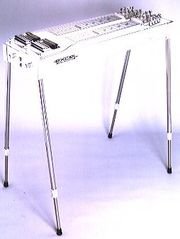
table steel guitar
The table steel guitar is an electric instrument, intermediate between the lap steel from which it developed and the pedal steel which in turn
developed from the table steel. It is designed to be placed on a table rather than played on the lap, or many instruments have built-in legs
(or, if you like, a built-in table). There are no pedals, so the player has only as many tunings available as there are necks.
The development of the lap steel guitar into the table steel guitar saw the introduction of amplification as standard, multiple necks, and
additional strings on each neck, first to seven, and eight strings per neck is now common. One, two, three and four neck instruments are not
uncommon. The two neck, eight string per neck configuration is particularly favoured in Hawaiian music.
The distinction between table steel guitar and lap steel guitar is fuzzy at best, and some makers and authorities do not use the term table
steel guitar at all, but refer to any steel guitar without pedals as a lap steel guitar even if playing it in lap steel position would
be quite impossible.
Pedal steel guitar
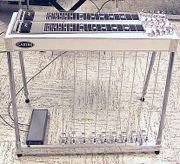
Pedal steel guitar
The pedal steel guitar is an electric instrument normally with 10 to 14 strings per neck, and sometimes two or even three necks, each in a different
tuning. Up to eight pedals (not counting the volume pedal) and up to five knee-levers are used to alter the tunings of different strings, which gives
the instrument its distinctive voice, most often heard in country music.
The extra strings and use of pedals gives even a single neck pedal steel guitar far more versatility than any table steel guitar, but at the same
time makes playing far more complex.
Steels
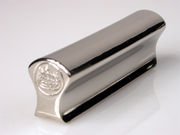
Saga Stevens Steel
The type of slide called a steel which gives the technique its name was probably originally made of steel, or the name may come from
the legend that the first steel was a railroad track.
Many materials are used, but nickel-plated brass is popular for the highest-quality slides, which are shaped to fit the hand and as a result have a
cross-section not unlike a railroad track.
Some cautions on terminology
The term steel guitar should not be confused with steel-strung guitar, which is a standard acoustic guitar that has steel rather than
the nylon or cat-gut strings used for classical guitar, and is built with extra bracing, a stronger neck, and higher-geared machine heads to cater
for the much higher tension of steel strings. The steel guitar takes its name from the type of slide used, not from the material of the strings.
The term Hawaiian guitar is often used for various types of steel guitar, but in Hawaiian music Hawaiian guitar means slack-key guitar,
a way of tuning a steel stringed acoustic guitar which is then played in the conventional position.
This article is licensed under the GNU Free Document License
It uses material from the Wikipedia article - Steel guitar
|
